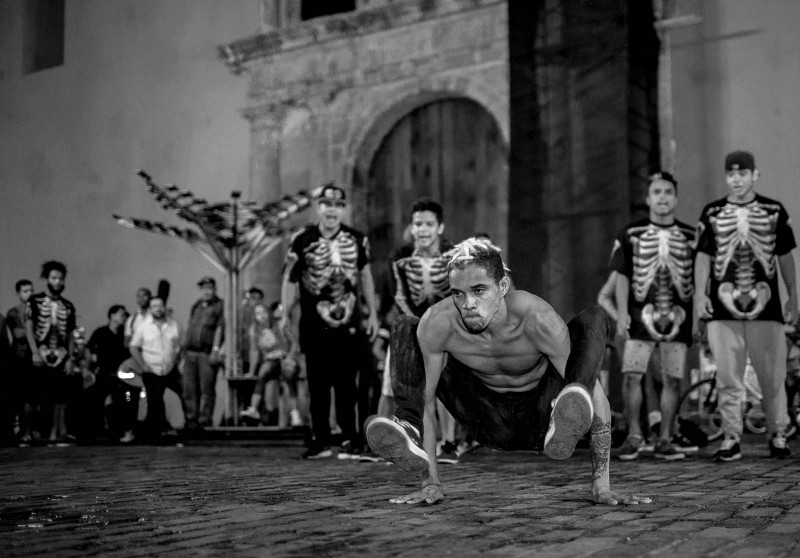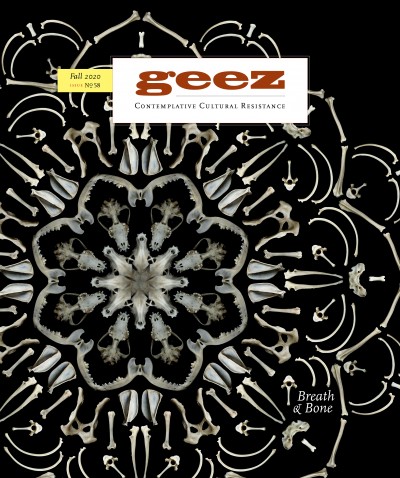Where Death Lives

Hope is found in the voices of breakdancers, rebelling against the power of death. Choreography by María Luz Nóchez, November 15, 2015, photo by Joaquín Sarmiento, Fundación Gabo CC.
Where I come from, death isn’t something you just wait for in old age.
Where I come from, death is something you protect from – with walls and gates, if you can afford them. With dogs and fists if you can’t. But the certain and eternal companion of walls and gates and dogs and fists is death’s best friend: the gun.
Death crawls in the night and cackles during the day. It attacks with jagged bullet teeth leaving countless teenage bodies behind. It aims its barrel at grandmothers’ heads and drags them off their land by the hair. It follows mothers and daughters down the street and into alleys. It patrols families and locks their children behind bars one by one. Death spreads like a virus behind barbed wire, spilling onto the streets covering more and more bodies with blood.
Where I come from, death’s brutality is felt, pressing itself onto you as a soundless terror. You feel it in the air some days. You smell it on the block. You hear it in the sirens and you touch it in the bullet cracks in walls. Sometimes you go days or weeks without feeling or thinking of death, but it always circles back to remind you of its horrific hunger because its belly has no bottom.
Where I come from, death is the primary import. Death was forcefully imported through Spanish gunpowder and disease. Death was forcefully imported through Ronald Reagan’s sale of weapons to death squads. Death is forcefully imported through Canadian and Swiss mining companies displacing entire Indigenous communities. Death is forcefully imported through Trump’s deportation of people who test positive for COVID-19. Death is forcefully imported through North American demand for drugs fuelling narcotrafficking.
Death is imported and life is exported. Life is exported through forced migration caused by racialized European, North American, and local empire and capital. Life is forcefully exported by the draining of rivers and raping of lands by racialized European, North American, and local political and economic elites. Life is forcefully exported through the brain drain funded by racialized European, North American, and local investors and technocrats. Life is forcefully exported through cultural exploitation by racialized European, North American, and local corporations and philanthropists.
Death has also made its way from the extraordinary into the ordinary. It has nested in our homes and communities. We feed death with every gesture, action, and proposal that bends us closer toward it. The preacher’s sermon that presumes the inferiority of women, Indigenous people, or LGBTQ+ folx. The board member’s proposal to reduce worker salaries to outdo the competition. The husband’s justification of aggression by blaming his partner. The presumption of criminality based on someone’s living area or skin colour. Each of these bends us toward death.
Where I come from, death leaves us with little to no hope when we don’t know where to look. Because it is from the sites of death, those we least expect, that true hope is born. Not a hope dressed in shallow optimism for a better future. Not a hope clothed in pitiful sentimentality that sheds tears over death but doesn’t search for and create life in its midst. And definitely not a hope in the very powers of death that feed on us in the first place.
Hope lives when we know what spaces to see and what voices to hear. So find the voices and spaces of the poets, the hip hop artists, the gardeners, the breakdancers, and the organizers. Pay attention to the grandmothers and grandfathers who feed the block with meals and stories. Notice the mothers refusing to forget their children, and the uncles fighting for their future relatives. Open your eyes to the transnational solidarity networks and the locally organized collectives. Find the voices where a cry of suffering has turned into a cry of protest, revolt, and hope. Find the spaces where a cry of protest, revolt and hope has turned into the (re)imagining and (re)creating of life in the midst of death.
Where I come from, life lives in the voices of Harriet Jacobs and Harriet Tubman, Aimé Césaire and Frantz Fanon, Ella Baker and Yuri Kochiyama, Rubén Blades and Curtis Mayfield, Óscar Romero and Rigoberta Menchú, Gloria Anzaldúa and bell hooks, Dead Prez and Rebel Diaz, Ana Tijoux and Rebeca Lane, Berta Cáceres and Thelma Cabrera. Where I come from, life lives in the spaces of the Young Lords and the Black Panthers, the Madres de Plaza de Mayo and the Combahee River Collective, the Zapatistas and the Rojava, Decolonize This Place and Black Lives Matter, No One Is Illegal and Elijo Dignidad.
In these spaces grow the seeds and trees of life, stained with blood, as the soil may be. In these voices sound the rhythms of life, pierced with wailing, as communities may be. They are the voices and the spaces neither waiting ignorantly for, nor protecting foolishly from, death. They have stared into and gone through death’s dark abyss. And they are (re)imagining and (re)creating worlds of life in the midst of a world of death.
Frank Scoffield Nellessen is a Guatemalan mestizo immigrant learning to decolonize and heal himself and his communities. He works in gang prevention in Los Angeles, California.



Start the Discussion